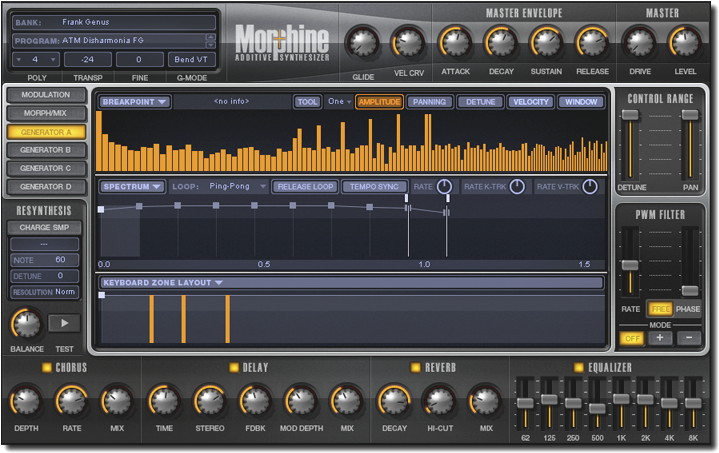INSTRUMENTS / GENERATORS
Morphine Additive Synthesizer 
TRIAL ONLY: Morphine is downloadable as a demo version in FL Studio and needs to be purchased separately so you can save projects containing Morphine channels.

Introduction
Morphine is an Additive Synthesizer with quite a few 'twists'. Additive synthesis creates sound entirely from sine wave harmonics and at first this may seem like a major limitation. However, Fourier Theory teaches us that any waveform can be decomposed into an infinite series of sine-waves, a harmonic series. That means Morphine can still create all your Subtractive Synthesis favorites: Square, Saw and Sine waves. It gets better, Morphine can also reproduce the complexity found in real sounds by smoothly interpolating a series of these harmonic 'snapshots', in real-time, to generate what is best described as 'synthetic samples'. In this way, programming Morphine will feel familiar to anyone who has used a Sampler, with the ability to assign sounds across the keyboard and to create crossfades, stacks or blends of any sound/s as desired; welcome to Morphine!
What can Morphine do?
Morphine is a 4 Voice (Generator) additive synthesizer with 128 harmonics per voice. The 'Morph' part of Morphine refers to an architecture that allows these 4 Voices to be mixed and morphed under user control. Sounds (Spectra) are generated by interpolating a series of spectral 'snapshots' that can be created from any input sample or manually drawn. The following is a list of Morphine's main capabilities in more detail:
- 4 Independent Generators - Generators are a complete set of Keyboard Zones (independent sounds mapped across the Keyboard). Each Keyboard Zone holds a unique Spectrum (a synthesized sound of any length).
- Unlimited Keyboard Zones Per-Generator - Every MIDI key can be programmed to hold a unique Spectrum.
- Spectra - Similar to a 'synthetic' sample. Spectra can be resynthesized from any sample or manually programmed.
- Resynthesis - Automatically transforms a sample into a Spectrum. That is, a series of harmonic snapshots (called Breakpoints) and puts these under complete user control.
- Breakpoints - A Breakpoint is a harmonic 'snapshot' at a given moment in time. The Spectrum interpolates a series of Breakpoints to re/create any sound.
- Noise Generator - The Noise Generator is a specialized extra voice designed primarily for injecting untuned noises into the final patch. This can improve the accuracy and realism of sounds.
- Morph / Mix - The 4 Generators can be Morphed / Mixed with a user specified envelope. The Morph/Mix envelope can be time or tempo based.
- Effects - Portamento, Distortion, Chorus, Stereo Delay, Reverb and 8-Band Graphic Equalization are available simultaneously.
- Coffee & Tea making - You wish.
- Amazing Sound - No problem!
Does Additive Synthesis Hurt?
Additive Synthesizers are rare enough that they exist in an atmosphere of mystique, rumour and fear. Some say that Additive Synthesis is so complicated that it makes FM synthesis appear to have the engineering complexity of a spoon. Fortunately the reality is a lot less scary, Morphine is only slightly more complex to master than a spoon and you will be feeding yourself in no time. Probably the best analogy is to consider Morphine a multi-sampler that can generate its own 'synthetic' samples. So how does Morphine do this? Any sound can be represented by an infinite series of harmonics (sine waves) that vary constantly in amplitude and phase. Morphine captures this harmonic variation as a series of snapshots, just like the still frames in a movie and then by playing back this 'harmonic movie', in real-time, almost any sound can be re/created in synthetic form. So there you have synthesis in Morphine, not so scary. The hardest part will be learning the jargon in this manual. If Morphine is a spoon, then the jargon welds a set of spring-loaded cheek-piercing bolts to it.
The harmonic snapshots are called Breakpoints, each is composed of three unique values, Amplitude (shown above), Panning and Detune. The 'harmonic movie' is an interpolated sequence of Breakpoints and is officially called a 'Spectrum'. The envelope-style display, middle of the screenshot above, shows a Spectrum composed of 10 Breakpoints. Spectra can be manually entered and edited using the Breakpoint Editor (the top-most window in the screenshot above) OR automatically generated from samples in a process called 'Resynthesis'. Now all you have to do is work out how not to jab yourself in the eye with your new spoon and you will be Additively Synthesizing like a pro. Still scared? Load the factory patches, sit back and use a straw...tastes just as good!
Plugin Credits:
Morphine was created by Maxx Claster exclusively for -